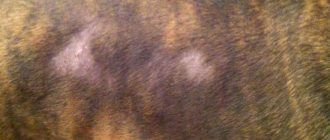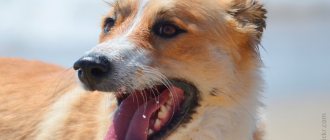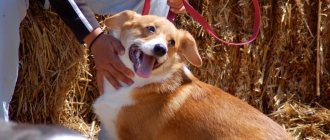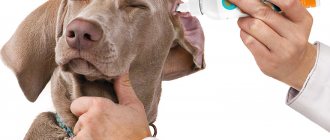The dachshund is often called the best burrow hunter in the world. After all, this breed was bred specifically for this.
Dachshunds are believed to have English, German and French blood.
The lifespan of a dog is up to 15 years, weight is 5-9 kg, height at the withers is 22-27 cm.
The dachshund is a cheerful, wayward and loyal animal that will become your true friend.
These dogs are easy to care for, but they still have some features that you need to know.
Discopathy - what is it?
Discopathy is one of the most common diseases among dachshunds.
The disease is characterized by loss of elasticity of the intervertebral discs. At the same time, some discs become thinner, crushed and are unable to perform their shock-absorbing functions. A process reminiscent of premature aging occurs in the Dachshund's spine.
NOTE!
The predisposition to discopathy is inherent in dachshunds at the genetic level. This is why a healthy pet can develop discopathy for no apparent reason.
Precautionary measures
You can save your dachshund from back problems if you follow a few rules. It is important to monitor your pet's activity. Ideally, the dog should not run fast, jump, tug of war, or perform other actions that are accompanied by excessive stress on the spine. You cannot play roughly with a dachshund, flounder, or abruptly pick up the dog, and both the owner himself and children, who often do not control their actions when playing with the dog, must understand this.
Care should be taken to ensure that the pet does not have access to stairs or to ensure that the animal climbs the stairs not by steps (even very slowly), but by a ramp (an inclined flat surface). Climbing stairs causes excessive pressure on the spine. You can feel the load that goes on a dachshund’s back when climbing steps if you imagine yourself trying to climb an obstacle that is taller than your own height. The steps of the stairs are often higher than the dog itself, so you need to protect your pet from climbing the stairs on his own.
Dachshunds love to jump and climb on furniture, but you shouldn't let them do this. Having patience and choosing the right approach to training, you need to wean the animal from jumping. If the dog is used to sleeping on the bed with the owner or likes to rest in places higher than its sleeping place, then you can install a ramp next to the bed, or control the dog’s movements and every time the animal wants to climb onto the sofa (bed) or jump off it, take it pick the dog up and carefully carry it.
An alternative option is to arrange a comfortable resting place in the crate, so that the dog does not feel that it is being punished, but perceives the crate as a place of solitude and relaxation.
It is recommended to walk your dachshund on a leash in combination with a harness, rather than a collar. The harness allows you to distribute the force from a tense leash over the body area, thereby reducing the risk of damage to the cervical vertebrae and back.
Representatives of the breed are active and energetic, they love to run, play, jump, and show curiosity, but this is the threat to animals. It is important to reduce the load on the back, but at the same time not radically limit the animals in what they like.
Dachshunds are prone to obesity, and excess weight provokes the development of a number of diseases that worsen the health of the animal, including intervertebral disc disease. Therefore, it is important to select commercial food in accordance with the age, physiological state, and activity level of the dog, or to create a correct balanced diet with an accurate calculation of the daily feeding rate for each specific dog. Daily walks (2-3 times a day) and regular exercise will help you avoid obesity.
Causes
There are several causes of discopathy in dachshunds, these are:
- Genetic predisposition . The reason is a mutation of certain genes, as a result of which the growth process of the vertebrae changes and the spinal canal narrows. In this case, the disease develops in dogs at a young age.
- Special body structure (elongated spine and short legs).
- Age-related changes . Most often, dogs that have reached 4-9 years of age suffer from this disease, even if the pet was absolutely healthy before that.
- Sedentary lifestyle . It was noticed that in dogs constantly engaged in burrow hunting, discopathy occurs much less frequently than in dachshunds leading a “domestic” lifestyle.
- Obesity . Body weight puts pressure on the vertebrae, causing them to experience additional stress and wear out faster.
- Excessive physical activity often contributes to rapid wear of the spinal discs.
Etiology
The cause of intervertebral disc disease is destructive changes in the disc itself as a result of cartilaginous metaplasia. There are also predisposing factors such as genetic predisposition (chondrodystrophic dog breeds), obesity, age from 3 to 6 years and, very rarely, spinal injury.
To better understand the occurrence of this process, you need to have a good understanding of the pathological physiology of the disease, which we will try to explain in a brief summary.
When the dog moves, the intervertebral disc serves as a load distribution in the spine, ensuring its stability and supportability. The intervertebral disc (IVD) itself is quite simple from an anatomical point of view. On the outside, it is represented by a fibrous ring consisting of collagen fibers that connect to the cartilage of the endplates of the vertebral bodies.
The external collagen fibers are connected to the ventral (lower) and dorsal (upper) longitudinal ligaments. In turn, the collagen fibers of the fibrous ring are connected to the internal structure of the intervertebral disc - the nucleus pulposus, which contains a large number of water molecules. In addition to water, the molecular composition of the intervertebral disc contains collagen and non-collagen proteins, a complex of proteoglycans and glycoproteins. Glycosaminoglycans (GAGs) are represented by proteoglycans. Their highest concentration is observed in the core of the intervertebral disc, where they are needed to bind water molecules.
Thus, with progressive pathological processes associated with disease or age, the concentration of proteogicans sharply decreases, which leads to a decrease in the concentration of water molecules in the nucleus pulposus and the fibrous ring of the intervertebral disc.
As for the age-related aspect of the disease, the aging process of the intervertebral disc is represented by fibroid metaplasia. The reason for this process is also associated with a decrease in the number of proteoglycans and, accordingly, water molecules in the disk. Chondrodystrophic breeds of dogs are predisposed to fibroid metaplasia, that is, to premature aging of the intervertebral disc.
.
Intervertebral disc diseases are divided into 2 types.
Hansen type 1 intervertebral disc disease is an extrusion (herniation) of the disc contents, that is, the nucleus pulposus, into the lumen of the spinal canal, which leads to compression of the spinal cord. The process of loss of disc contents occurs quite quickly or even at lightning speed, which characterizes the acute course of the disease and the development of corresponding clinical signs. Middle-aged dogs between 2 and 6 years old are predisposed to this type of intervertebral disc disease, and most often these are chondrodystrophic dog breeds, such as dachshunds, bulldogs, and pugs. In these dog breeds, degenerative disc changes can begin at an early age, around 3 months. Therefore, dogs with a herniated intervertebral disc that are not included in the above age category are often brought in, for example, at one year of age.
In 65-71% of cases, herniated discs are formed at the level of Th 11 and L2. (Brown NO, Helphrey M.L., 1977, Hoerlein BF Oliver JE, 1987). The next place in terms of frequency of damage (6-7%) is occupied by the cranial part of the cervical spine (C2-NW and C3-C4). In third place are the lumbar vertebrae (L2-L3 and L3-L4) (Hoerlein BF, 1987). There is an almost complete absence of herniated intervertebral discs at the Th 1-Th 10 level, which is explained by the presence of the rib cage and the ligament that fixes the heads of the namesake ribs.
Hansen type 2 intervertebral disc disease is characterized by gradual bulging of the annulus fibrosus into the lumen of the spinal canal without rupture, which leads to gradual compression of the spinal cord.
This type of disease is characterized by a slowly progressive course and occurs in older dogs from 6-7 years of age. Degenerative changes in the disc with this type of disease occur gradually. Non-chondrodystrophic dog breeds, such as German and East European Shepherds, Labradors, and Golden Retrievers, are predisposed to this type.
Hansen type 2 intervertebral disc disease also includes degenerative lumbosacral stenosis (cauda equina syndrome) or lumbosacral stenosis. With this pathology, between the last lumbar vertebra and the sacrum (segment L7-S1), the intervertebral disc undergoes degenerative changes and it bulges into the lumen of the spinal canal with compression of the nerves in this segment - compression of the cauda equina. This type of intervertebral disc disease belongs to Hansen type 2 with the formation of osteophytes in the area of the foramen and osteophytes in the area of the vertebral endplates. Middle-aged and elderly dogs of the following breeds are predisposed to lumbosocral stenosis: German Shepherd, Labrador Retriever, Border Collie.
Symptoms of the disease
At the initial stages, discopathy in dachshunds is asymptomatic and often goes unnoticed. Only when the dog begins to experience pain and worry do they pay attention to the problem.
But, there are a number of symptoms that can help identify discopathy in the early stages:
- The pet behaves restlessly, cannot lie down, find a place or the right position.
- The dog becomes sad, depressed, and does not jump for joy.
- The dachshund refuses to go up and down stairs, climb to high places, or make any physical effort.
- A hunched back and tense abdomen in a dachshund can indicate both discopathy and other diseases of the musculoskeletal system.
- Shuffling, limping, change in gait, decreased sensitivity in paws.
- Paralysis of limbs.
- Uncontrolled urination and defecation.
Expert opinion
Tolkachev Andrey Mikhailovich
veterinarian
Don't wait until your dog becomes paralyzed, because it is not difficult to detect discopathy in the early stages. To do this, you just need to be attentive to your pet and regularly show it to the veterinarian. Another important point is that if your dog is diagnosed with discopathy, you should not allow it to breed, this way you can reduce the number of animals genetically predisposed to the disease.
Vaccinations for dachshunds: when and which ones to give?
The most common vaccinations given to dachshunds are against rabies, hepatitis, adenovirus, leptospirosis, viral enteritis, and distemper, and they are given while still a puppy. Some of the diseases can be dangerous to humans, so there is no need to describe their importance.
The vaccination schedule is as follows:
- The first vaccination is performed when the puppy is 2 months old (plague, enteritis, hepatitis, adenovirus).
- After 2 weeks, the procedure must be repeated.
- The next stage begins at 7 months (plague, enteritis, hepatitis, adenovirus, leptospirosis).
- Further comprehensive vaccination is carried out at 1 year of age and includes a rabies vaccination. From now on until the end of the dachshund's life, vaccination must be performed once a year.
Diagnostic methods
In modern veterinary medicine, there are several methods for diagnosing discopathy:
- Visual inspection . At the same time, the veterinarian evaluates the dog’s skills: walking, jumping, reflex speed, presence of pain, etc.
- If the dog partially or completely lacks sensitivity in the limbs, the doctor assesses the time of onset of paralysis . It is believed that if more than 12 hours have passed since the moment of immobility, then it is no longer possible to restore the function of bowel movements, since it is impossible to restore the function of neurons.
- X-ray studies . In this case, an x-ray allows you to detect changes in the spine, exclude diseases of the vertebrae, and also allows you to detect the presence of injuries.
- MRI (magnetic resonance imaging) allows you to see an accurate and complete picture of the condition of the dog’s spine. The study is done layer by layer in a three-dimensional projection, which makes it possible to understand the picture of the disease as a whole. During the MRI, the animal is under the influence of sedatives.
- Myelography is a research method in which a contrast agent is injected under the arachnoid membrane of the dog's spinal cord, and then an X-ray examination is performed.
Forecast
The prognosis for intervertebral disc disease depends on many factors: time, degree of neurological deficit, and so on.
Comparative prognosis for cure:
| Neurological picture | Type of treatment | Prognosis for therapeutic treatment | Prognosis for surgical treatment |
| Paraplegia, absence of HBC | 24-48 hours – surgical decompression. More than 48 hours – surgery is not recommended | 5% | 24-48 hours - 45-76%. More than 48 hours – 6-33% |
| Paraplegia, there is GBH. No superficial sensitivity | Surgical decompression | 50% | 86-89% |
| Paraplegia, HBH yes | Surgical decompression | 51% | 79-96% |
| Paraparesis, lack of mobility | Surgical decompression | 55-85% | 83-95% |
| Paraparesis, ambulation function present | Therapeutic treatment | 55-85% | 83-95% |
| Only pain syndrome | Therapeutic treatment | 55-85% | 83-95% |
General treatment regimen
After the examination is completed, the veterinarian makes a decision on treatment methods.
At the appointed time, the dog is given general anesthesia and the operation begins. During the damage operation, the disc is removed. If necessary, the doctor opens the dura mater of the spinal cord to reduce pressure on it and improve its conductivity and metabolic processes occurring in it.
After the operation, the animal undergoes a rehabilitation process, during which it is prescribed painkillers, anti-inflammatory drugs, and antibiotics.
After the rehabilitation period, the dog is prescribed physiotherapeutic procedures, as well as vitamins. All this will allow the pet to return to its normal lifestyle.
IMPORTANT!
Even after successful removal of the damaged disc, relapses are possible in dachshunds.
How to detect intervertebral disc disease in dogs?
The diagnosis is made comprehensively, taking into account a set of symptoms and the results of special diagnostic studies.
During a neurological examination, we can roughly establish the location of the disease and assess the degree of neurological deficit.
Special diagnostic research methods are:
- radiography, which makes it possible only to determine the localization of the lesion by indirect signs;
- myelography - the introduction of a special radiopaque substance into the spinal canal, after which we see the place of compression on the x-ray;
- Computed tomography (CT) or magnetic resonance imaging (MRI) also provide clear visualization of disc extrusion, but in addition, they allow visualization of the spinal cord and the consequences of the compression exerted on it.
Intervertebral disc herniation on MRI. Rice. 1.
Intervertebral disc herniation on MRI. Rice. 2.
Drug treatment
At the initial stage of the disease, drug treatment is allowed, which helps relieve symptoms, but does not cure the disease.
For conservative treatment of discoptia, the veterinarian prescribes:
- Corticosteroid hormones.
- Vitamin "B" injections.
- Non-steroidal anti-inflammatory drugs such as Rimadyl, Previcox, Ketofen.
- Painkillers.
- Chondroprotectors to maintain cartilage structure, such as Flexan. Such substances contain bioactive collagen molecules, which slow down degenerative processes in the spine.
- Drugs that relieve inflammation, for example, Canina Petvital Frnhro tabletttn. Such drugs help to establish balance in the inert tissue and increase the elasticity of the ligaments, which bear additional stress due to the loss of functionality of the spinal disc.
Surgical intervention
The choice of technique is made by the doctor depending on which part of the spine is affected.
Surgical methods for treating discopathy in dachshunds:
- Ventral slits method . With this technique, the doctor drills a small window between two vertebrae at the level where the affected disc is located. After this, either part of the disk or the entire disk is removed. The technique is used for disc pathologies in the cervical spine.
- Hemilaminectomy . With this technique, access to the spine is through the processes of the joints. The method is used for disc pathology in the thoracic or lumbar region.
- Dorsal laminectomy . In this case, access to the spine is carried out from above due to the fact that the vertebral arch is removed.
Dachshund skeleton
The dachshund skeleton consists of the skull, lower jaw, scapula, humerus, radius, carpus, ulna, metacarpus, tibia, tarsus, metatarsus, hip, fibula, sternum, patella (patella), phalanx, cervical, thoracic, lumbar, sacral, caudal vertebrae and calcaneal tubercle.
Preventive measures
Methods for preventing discopathy in dachshunds:
- Moderate physical activity is an excellent prevention of excess weight.
- Under no circumstances should you pick up a dachshund under your arm. You can only lift a dog by placing one hand under its front legs and the other under its hind legs.
- Don't let your dachshund jump on or off the couch.
- Carefully monitor your pet's diet and do not overfeed it.
- Be sure to give your dog vitamins and special supplements rich in microelements and nutrients.
- Swimming, massage, jogging must be present in a dog’s life.











